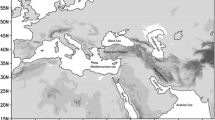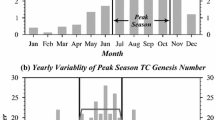Abstract
Changes in the frequency and air pressure of cyclones that enter or are formed within the Arctic basin are herein examined by applying the database of cyclones created using NCEP/NCAR re-analysis. The Arctic basin is defined as the area north of latitude 68° N. Deep cyclones with a mean sea level pressure (SLP) of below 1,000 hPa, were analysed separately from shallow cyclones. Changes in the variables in the first, last, deepest and northernmost points of cyclones were studied. The cyclones were grouped into sectors by using the point on latitude 68° N at which the cyclone entered the Arctic region. The analysis described herein shows that the frequency of incoming cyclones, i.e. those that entered the Arctic basin, increased significantly during the period 1948–2002, but that the frequency of Arctic cyclones formed within the Arctic basin did not. The frequency of deep cyclones that entered the Arctic basin, as well as the frequency of cyclones that formed within it, clearly increased, while the frequency of shallow Arctic cyclones decreased. The most significant changes in the seasonal parameters associated with the cyclones occurred in winter. The mean annual SLP of deep cyclones decreased significantly, particularly for deep Arctic cyclones. The frequency of incoming cyclones showed an increase in the Bering Strait, Alaskan, Baffin Sea, and East Siberian sectors.
Similar content being viewed by others
References
Alekseev GV, Aleksandrov EI, Svyashchennikov PN, Kharlanenkova NE (2000) O svaimosvyazi kolebanij klimata v Arktike i v srednih i nizhkih shirotah (Correlation of climate oscillations in the Arctic and middle and low latitudes). Meteorol Gidrol 6:5–17
Bengtsson L, Semenov VA, Johannessen OM (2004) The early twentieth-century warming in the Arctic: a possible mechanism. J Climate 17:4045–4057
Blender R, Schubert M (2000) Cyclone tracking in different spatial and temporal resolutions. Mon Weather Rev 128:377–384
Box JE (2002) Survey of greenland instrumental temperature records: 1873–2001. Int J Climatol 22:1829–1847
Brümmer B, Thiemann S, Kirchgäßner A (2000) A cyclone statistics for the Arctic based on European Centre re-analysis data. Meteorol Atmos Phys 75:233–250
Comiso JC, Parkinson CL, Gersten R, Stock L (2008) Accelerated decline in the Arctic sea ice cover. Geophys Res Lett 35:L01703. doi:10.1029/2007GL031972
Grigoriev S, Gulev SK, Zolina O (2000) Innovative software facilitates cyclone tracking and analysis. Eos 81(16):170
Gulev SK, Zolina O, Grigoriev S (2001) Extratropical cyclone variability in the Northern Hemisphere winter from the NCEP/NCAR reanalysis data. Clim Dyn 17:795–809
Jung T, Hilmer M, Ruprecht E, Kleppek S, Gulev SK, Zolina O (2003) Characteristics of the recent eastward shift of interannual NAO variability. J Climate 16:3371–3382
IPCC (2007) Climate Change 2007: Synthesis report. In: Core Writing Team, Pachauri RK, Reisinger A (eds) Contribution of working groups I, II and III to the fourth assessment report of the intergovernmental panel on climate change. IPCC, Geneva
Kalnay E, Kanamitsu M, Kistler R, Collins W, Deaven D, Gandin L, Iredell M, Saha S, White G, Woollen J, Zhu Y, Leetmaa A, Reynolds R, Chelliah M, Ebisuzaki W, Higgins W, Janowiak J, Mo KC, Ropelewski C, Wang J, Jenne R, Joseph D (1996) The NCEP/NCAR 40-year reanalysis project. Bull Am Meteorol Soc 77:437–472
Kolpinov NI, Kolpinova VA (2004) Cikloničeskaja dejatel‘nost‘ v zapadnom sektore Rossijskoj Arktiki. Meteorol Gidrol 1:46–52
Lambert SJ (1996) Intense extratropical northern hemisphere winter cyclone events: 1899–1991. J Geophys Res 101:21319–21325
Link P, Post P (2007) Spatial and temporal variance of cyclones in the Baltic Sea region. In: Proceedings from the 5th annual meeting of the European meteorological society session AW8: weather types classifications. COST Action 733, EU Publications Office, pp 69–76
Lüpkes C, Vihma T, Birnbaum G, Wacker U (2008) Influence of leads in sea ice on the temperature in the atmospheric boundary layer during polar night. Geophys Res Lett 35:L03805. doi:10.1029/2007GL032461
Maslanik JA, Fowler C, Stroeve J, Drobot S, Zwally J, Yi D, Emery W (2007) A younger, thinner Arctic ice cover: increased potential for rapid, extensive sea ice loss. Geophys Res Lett 34:L24501. doi:10.1029/2007GL032043
McCabe GJ, Clarc MP, Serreze MC (2001) Trends in Northern Hemisphere surface cyclone frequency and intensity. J Climate 14:2763–2768
Mote TL (1998) Mid-tropospheric circulation and surface melt on the Greenland ice sheet. Part II: synoptic climatology. Int J Climatol 18:131–145
Orlanski I (1998) On the poleward deflection of storm tracks. J Atmos Sci 55:2577–2602
Polyakov IV, Berkyaev RV, Alekseev GV, Bhatt US, Colony RL, Johnson MA, Maskshtas AP, Walsh D (2003) Variability and trends of air temperature and pressure in the maritime Arctic, 1875–2000. J Climate 16:2067–2077
Przybylak R (2003) The climate of the Arctic. Kluwer, Dordrecht
Rudeva I, Gulev SK (2007) Climatology of cyclone size characteristics and their changes during the cyclone life cycle. Mon Weather Rev 135:2568–2587
Schneidereit A, Blender R, Fraedrich K, Lunkeit F (2005) Icelandic climate and North Atlantic cyclones in ERA-40 reanalysis. Meteorol Z 16:17–23. doi:10.1127/0941-2948/2005/0012-0003
Sepp M (2009) Changes in the frequency of the Baltic Sea cyclones and their relationships with NAO and climate variability in Estonia. Boreal Env Res 14:143–151
Sepp M, Post P, Jaagus J (2005) Long-term changes in the frequency of cyclones and their trajectories in Central and Northern Europe. Nord Hydrol 36:297–309
Serreze MC, Barrett AP (2008) The summer cyclone maximum over the central Arctic Ocean. J Climate 21:1048–1065
Serreze MC, Carse F, Barry RG, Rogers JC (1997) Icelandic low cyclone activity: climatological features, linkages with the NAO and relationships with recent changes in the northern hemisphere circulation. J Climate 10:453–464
Serreze MC, Walsh JE, Chapin SF III, Osterkamp T, Dyurgerov M, Romanovsky V, Oechel WC, Morison J, Zhang T, Barry RG (2000) Observational evidence of recent change in the northern high-latitude environment. Clim Change 46:159–207
Serreze MC, Holland MM, Stroeve J (2007) Perspectives on the arctic’s shrinking sea-ice cover. Science 315(5818):1533–1536
Simmonds I, Burke C, Keay K (2008) Arctic climate change as manifest in cyclone behaviour. J Climate 21:5777–5796
Sorteberg A, Walsh JE (2008) Seasonal cyclone variability at 70°N and its impact on moisture transport into the Arctic. Tellus 60A:570–586
Vihma T, Jaagus J, Jakobson E, Palo T (2008) Meteorological conditions in the Arctic Ocean in spring and summer 2007 as recorded on the drifting ice station Tara. Geophys Res Lett 35:L18706. doi:10.1029/2008GL034681
Vize VJ (1937) Pričina poteplenija Arktiki. Soveckaja Arktika 1:59–68
Wang XL, Swail VR, Zwiers FW (2006) Climatology and changes of extra-tropical storm tracks and cyclone activity: comparison of ERA-40 with NCEP/NCAR reanalysis for 1958–2001. J Climate 19:3145–3166
Yarnal B (1993) Synoptic climatology in environmental analysis: a primer. Wiley, Hoboken
Zhang X, Walsh JE, Zhang J, Bhatt US, Ikeda M (2004) Climatology and interannual variability of Arctic cyclone activity: 1948–2002. J Climate 17:2300–2317
Zolina O, Gulev SK (2002) Improving the accuracy of mapping cyclone numbers and frequencies. Mon Weather Rev 130:748–759
Author information
Authors and Affiliations
Corresponding author
Rights and permissions
About this article
Cite this article
Sepp, M., Jaagus, J. Changes in the activity and tracks of Arctic cyclones. Climatic Change 105, 577–595 (2011). https://doi.org/10.1007/s10584-010-9893-7
Received:
Accepted:
Published:
Issue Date:
DOI: https://doi.org/10.1007/s10584-010-9893-7




